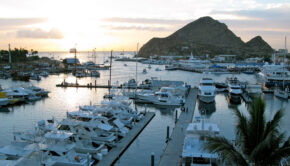Offshore giant schools offwind fliers
Published on May 4th, 2021
In the land of downwind distance races and ultra-light yacht design, it was the round the world Volvo 70 that decimated the monohull record for the biennial 800nm Newport to Cabo San Lucas Race. Here’s an excerpt from Ross Tibbits’ report for Latitude 38:
Pyewacket is a modified Volvo 70 (ex-Black Jack, ex-Telefonica), built for the 2011 Volvo Ocean Race. Brian Janney, who shares forward sail-trimming duties with Scott Easom, conveys the details of Pyewacket’s modifications, which were primarily made when she was in Australia as Black Jack.
“They put a longer bowsprit on her, a taller mast that’s 3 meters longer than the standard Volvo 70, a longer boom, and they added a deeper keel (drawing 18 feet) with a lighter bulb. I believe the boat is now about 2,000 pounds lighter than it once was.”
With these modifications in hand, new sails had to be designed as well. The bigger sails and lighter weight weren’t ideal for Australia’s long-distance reaching races. But here on California’s West Coast, the boat’s configuration is ideal and very powerful. The taller mast powers everything up.
“Our headstay is at the masthead of a normal Volvo 70 rig. So, it’s kind of a different way of thinking about things. We reef downwind and even upwind quite quickly, and when we reef, we still have the same size main as a normal Volvo 70.”
Controlling the boat gets complicated quickly. There are numerous forward sails to choose from (all furling), twin daggerboards, twin rudders, a canting keel and so forth.
“That boat is so complicated,” says Roy (owner Roy Disney). “There are so many intricate moving parts, between rig settings and keel settings and the right winch at the right time, because they’re all hydraulically driven. If you run three winches at the same time, the motor turns off, which is a problem, so you have to do this little ballet. We have to practice each time before we do a race just for that reason.
“Furling is its own little animal. You don’t tack these boats, you furl them and then tack them. Then you have to tack the keel. That’s another whole issue because if you don’t do that at the right speed — and we still haven’t quite figured that one out — things go amiss.
“Sometimes I’ll be driving and Gary Weisman will be doing the keel, and he’ll have to run across the boat and he’ll have forgotten [about the keel] and suddenly all the sails are on the other side with the keel and — it’s awkward. We all have senior moments.” – Full story









 We’ll keep your information safe.
We’ll keep your information safe.